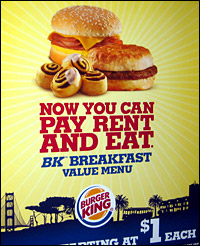
Is a change coming to your cart?
Photo: iStockphoto
Hey you, in the supermarket line — yeah, you, the one with the stuffed cart. Are you ready to pay up for those groceries?
You’d better be, pal. That’s the message from Bill Lapp, former chief economist for the food giant Conagra. “I think [U.S.] consumers are more prepared than we realize to accept higher prices on food and I think that’s part of our future,” Lapp recently declared. “It’s largely been set in stone for us already.”
For decades, average Americans have spent just 10 percent of disposable income on food — the lowest proportion in the world and almost surely the lowest in the history of the world. Of course, that means well-off people pay considerably less than that — and low-income people pay considerably more.
Indeed, as we head into this future that’s been “set in stone for us already,” it’s important to note that 10.9 percent of U.S. households, representing 12.6 million families, already qualify as “food insecure” by USDA standards. For these folks — and for people in the global south who have been rioting in response to being priced out of the food market — spiraling costs may be impossible to accept, no matter what the former Conagra guy says. They will be forced into wrenching decisions — what to eliminate from their budgets to keep the food coming.
Perhaps with this demographic in mind, Burger King recently ran an ad campaign in Bay Area subway stations featuring giant images of sausage biscuits and sweet rolls. “Now you can pay rent and eat,” the text declares, heralding “10 items available for $1 each.”

But how do I live with myself?
Courtesy Cecily Upton
As I’ve written before, such cheap, unhealthy food plays a key role in our economic system, sustaining a low-income service workforce in an era of falling wages. Now, even as prices rise for corn and soy — key inputs in the industrial-food system — the Burger King ad may herald the shape of things to come: a scramble to keep supplying cheap food amid elevated raw-material costs.
Giant corporations like Burger King have the economies of scale and market power to hold prices down, mostly by leaning on their suppliers (i.e., farmers). In Florida, source of the fast-food industry’s winter tomatoes, Burger King has steadfastly refused to pay farmworkers an extra penny per pound picked. According to Fast Food Nation author Eric Schlosser, the penny-per-pound raise would double the wages of thousands of workers now mired in poverty and cost Burger King about $250,000 — a fraction of annual profits, and even less than an average executive’s salary.
McDonald’s and Taco Bell had agreed to the raise in the last couple of years, but Burger King threatened to shift its tomato buying to Mexico rather than pay up. Burger King’s refusal scuttled the deal, and now tomato workers make the same old poverty wage. Evidently, in this new age of pricier food, corporations will literally pinch pennies to keep costs down.
Looking Beyond the Sticker Price
On the consumer side, the trend to higher prices often means a scramble to economize. I saw that in a recent trip to a supermarket in a low-income section of North Carolina’s Triangle area. In the meat aisle, I saw people carefully comparing prices, and gravitating to sale items.
I asked one woman, scrutinizing a beef chuck roast on sale for half off, what she thought. She told me chicken prices had gotten much higher, so she was surprised to find herself buying more beef for her family — something she didn’t used to do so much. “There’s been some good sales on beef,” she said, plopping the roast into her cart.
As she spoke, I remembered reading that prices for beef hadn’t risen as rapidly as those for chicken; the big beef producers had been reluctant to pass on their higher costs to consumers, hoping to protect their market share. And since four giant companies slaughter 83.5 percent of U.S. cows, such companies are masters of maintaining profitability by cutting costs.
But low costs in the supermarket come at a price.
The massive recent recall imposed on a smallish beef packer in California — sparked by revelations that workers had tortured “downer” cows and pushed them into the food supply — comes to mind. For a beef packer facing severe cost pressures, hustling severely sick cows into the food supply might have seemed like a rational choice.
Likewise, beef and dairy feedlot operators are rushing to replace expensive corn with cheaper “distillers grains” in their feed rations. Use of distillers grains, a waste product from the corn-ethanol process, seems to significantly increase the incidence of the deadly E. coli 0157 virus in cows, among other environmental and public-health consequences.
I wonder what other corners are being cut to keep those “good sales on beef” coming.
Every Downer Cow Has a Silver Lining
Americans, particularly low-income ones, find themselves at a precarious juncture. Not only are food prices rising rapidly for the first time in decades, but gas prices hover near all-time highs, even adjusted for inflation. Adjustable mortgage rates — the only kind people with shaky finances can hope for — continue their upward swing. Last year, 1.5 million U.S. families got hit with foreclosures, and Federal Reserve chief Ben Bernanke recently warned of more of the same in the year ahead. The economy, meanwhile, seems tilted toward a recession. That means job cutbacks, and downward pressure on wages.
As Naomi Klein shows in her recent book The Shock Doctrine, such economic crises have often been used to consolidate corporate power. You can see Klein’s thesis at play in Burger King’s recent actions: squeezing low-income workers in one area in order to make money selling cheap food to low-income workers in another.
But shocks also open opportunities for positive change.
As prices for industrial food inch up, food grown close to home, free of increasingly expensive agrichemicals and not shipped cross-country with ever-more-dear gas, has a chance to be more competitive. Now more than ever, it’s critical to patronize your nearby farmers’ market, buy a CSA share, participate in (or start) a local-food council in your area, and harangue your congressional representatives to support Community Food Projects — federal programs, funded by the farm bill, designed to bring healthy, affordable food into low-income areas.
Amounting to just $10 million annually — equivalent to a rounding error in the context of the mammoth farm bill — Community Food Projects currently stand in jeopardy of being cut [PDF]. Don’t let the scoundrels get away with it.


